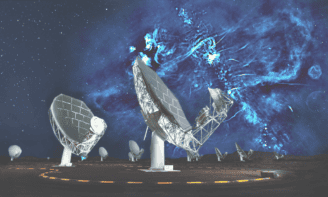The Sloan Digital Sky Survey has released its first images. The $77 million telescope will observe more than 100 million stars, galaxies and quasars over the next five years and produce the first detailed three-dimensional map of the sky. The images were presented earlier this week at the 192nd American Astronomical Society meeting in San Diego.
The 2.5 m Sloan telescope is based at Apache Point Observatory in New Mexico. The telescope has an unusually wide field of view and one of the most advanced digital cameras ever built. The camera consists of 30 charge-coupled devices (CCDs), each containing four million picture elements. One night’s observing will produce up to 200 gigabytes of data on a dozen tapes. Astronomers record three-dimensional information by fitting an aluminium plate containing 640 small holes onto the focal plane of the telescope. These holes mark the location of objects observed by the telescope. Light passing through the holes is collected with fibre optics and piped to a spectrograph which analyses the redshift and hence the distance to the object. Astronomers hope that the survey will help refine theories of how the universe’s structure formed after the Big Bang.



